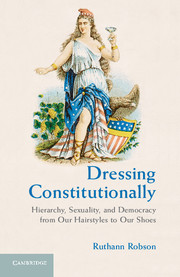5 - Dressing Disruptively
Published online by Cambridge University Press: 05 July 2013
Summary
The notion that attire is capable of disruption presupposes not only a normative style of dress but also a normative community that is capable of being disturbed merely by a person’s apparel or grooming. As a general matter, perhaps it is difficult to believe that what a person is wearing, other than a weapon, could have that much power. More specifically, it might be difficult to believe that armbands, hats, purses, T-shirts, jackets, saggy pants, or even shackles and masks could be so potent. However, as these examples illustrate, it is less the article of clothing itself than what it symbolizes: a threat to a presumptively democratic status quo.
While the focus is usually on the disruptive agent, the threatened normative order merits closer examination. The commonly accepted candidates, often echoed as the government’s interests in litigation regarding the constitutionality of regulating dress or grooming, include school discipline, courtroom decorum and fairness, or even the social fabric. But these formulations are both too narrow and too general. Site-specific constitutional doctrine can obscure the broader issues of hierarchy, democracy, or sexuality that are always at stake. General abstractions seeking to preserve order in schools, courtrooms, or society easily slip into deference to governmental officials and risk a type of fascistic order antithetical to democracy and democratic constitutionalism. The doctrine of disruption, most closely associated with schools, exemplifies these problems.
- Type
- Chapter
- Information
- Dressing ConstitutionallyHierarchy, Sexuality, and Democracy from our Hairstyles to our Shoes, pp. 103 - 127Publisher: Cambridge University PressPrint publication year: 2013



